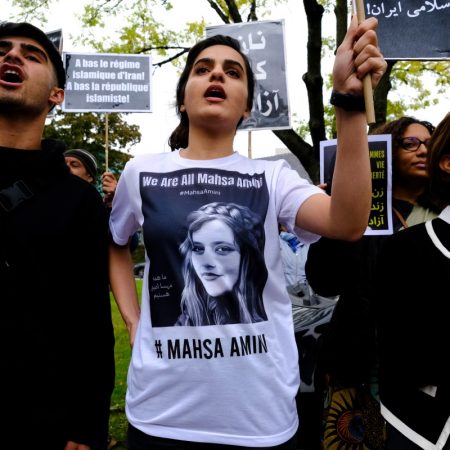Lebanon: Rebuilding Infrastructure … Again
Part 7: (2007 – 2012)
By Laura Fawaz, Contributing Reporter
Getting over the third Israeli invasion devastated more than a lost of human life in Lebanon, it took over Lebanese day-to-day life, with a constant reminder of what was lost.
 |
Lebanese Hizbullah supporters sweep the street in a destroyed residential area in southern Beirut. Photograph: Kevin Frayer/AP |
In last week’s article, we discussed Israeli’s 2006 invasion, in which Israel admittedly intended to attacked Lebanon’s infrastructures, bridges, roadways, airport, and even hospitals. This was so that the people inside Lebanon would be trapped in their own homes, literally. For safety concerns, most families were not able to take shelter in near by hospitals due to the fact that anyone on road was seen as a moving target. We also spoke with a young lady named Ann in our last article that described seeing numerous cars trying to drive to shelter, but they knew it had to be done in a safe manner. So they would have two people in the back seat of the car, each holding one side of a large white flag, the symbol of a peace. Though according to Ann, this made no difference as she remembered seeing approximately every third car still hit with a missile, with their white flag desecrated to pieces.
In this war, Israel hoped to show the Lebanese government and people that Hezbollah was nothing but a tyrant militia that brought death and destruction. They hoped that this lesson would turn popular opinion against the resistance group, though rather, it did the opposite. With most Lebanese increasing their support for Hezbollah, including the Lebanese Christians who normally were not friendly to Islamic parties. Everyone now was blaming Israel for attacking civilian targets, and in the end, this small Lebanese resistance group, Hezbollah, declared victory in this 34-day war. The specific attacks leading to this war is regarding the large number of prisoners of war. Remember, Israel had five, Lebanon had approximately 360, and Palestine had over 6,800.
There was an agreement between Israel and Hezbollah that Israel would release an agreed upon number of the Lebanese and Palestinian prisoners of war, in exchange for the five that Hezbollah had. But for whatever reason, Israel did not follow through with this agreement, thus leading to the 2006 July war. But in July 2008, Israel and Hezbollah initiated another agreement stating that Hezbollah would turned over the captured Israeli soldiers in exchange for Lebanese civilian prisoner Samir Kuntar, as well as four Hezbollah fighters captured during the July war. Also requested in this exchange were the bodies of approximately 200 other deceased Lebanese and Palestinian fighters held by Israel. Kuntar and the other released fighters, were greeted by a hero’s welcome in Beirut, with celebrations taking place in every town and village.
Since the July war, Lebanon was dedicated to rebuilding it’s infrastructure, yet again. Though this time, the rebuilding process began the day after the war ended. Unlike the people affected by Hurricane Katrina in New Orleans, the Lebanese people that were affected by the war were reimbursed immediately. How? Hezbollah was the one that handled it, not the Lebanese government. They made sure of it, by giving the affected people money to rebuild right away. But this time, they rebuilt bigger and better. For example, homes in South Lebanon that had to be rebuilt were now set up with solar powered heating on their roofs.
Then in October 2009, the Lebanese government established diplomatic relations with Syria, being the first time since both countries gained independence in 1940s. Within that year, Lebanon is once again; trying to make sure that every religious sect is represented in government. The Druze minority in Lebanon is growing, and is now a politically influential minority. Though unity in the government did not last, because in January 2011, the government collapses yet again. This time, it collapsed after Hezbollah and allied ministers resign. They did so after the western-backed Prime Minister Saad Hariri refused to assemble ministers to discuss how to deal with the naming of suspects in the killing of his father back in 2005. The announcement was timed to coincide with the start of a meeting at the White House between Hariri and Barack Obama.
All 10 opposition ministers resigned, along with Adnan Sayyed Hussein, a minister aligned to Lebanon’s president. His resignation was crucial because it meant more than one third of the cabinet had quit – a move that meets a requirement to bring about the collapse of the government. The energy minister, Gebran Bassil, said Hariri must choose between “Beirut, or Washington, or Beirut and any other capitalâ€.
Still not able to take over Lebanese land, Israel realized that the route to Hezbollah was through those who support them, financially and otherwise: Iran and Syria. The best method of getting to these countries was through American influences and connections. Thus, in early 2012 is when the talks of invading Iran really became a possibility. Though after many Americans protested the idea, citing the disaster that happened in the Iraq war invasion, the idea was put to the back burner.
With the next target in mind, America tried to convince more of the world to go after Syria. The conflict within Syria began in March 2011, and of course, as intended, spilled over into Lebanon in the summer of 2012. With opposition fighters in Northern Lebanon, this time, people were fleeing south. It just so happens, that once again, I was there in November 2012. After completing the fulfilling pilgrimage of Haj, I stopped in Lebanon to visit family members. There, I found a difference in the atmosphere within Lebanon. In the south, where my aunts and uncles live, it was a peaceful lifestyle, with a homey, neighborhood feel, all without the worry of incoming bombs. In the north though, I could not tell you first hand as I was instructed not to go north of Beirut due to the clashing of political groups in Syria and Lebanon.
There is a whole other story when it comes to these “groups†though. Some say that they are the homegrown terrorists that came in Syria from neighboring countries to try to overthrow the government. While others say that they are CIA trained groups trying to overthrow President Bashar Al-Assad for supporting Hezbollah, the only group that has been able to beat Israel. These were the two stories that I heard while in Lebanon, and as an American, was skeptical of course. But then I was reminded that Saddam Hussein, the tyrant who ran Iraq pre-American invasion, was also CIA trained. According to http://www.democracynow.org/, a broadcast of NPR, his first contacts with U.S. officials date back to 1959, when he was part of a CIA-authorized six-man squad, tasked with assassinating then Iraqi Prime Minister General Abd al-Karim Qasim. 2012 ended with 160,00 Syrian refugees streaming into Lebanon following several days of deadly fighting between supporters and opponents of the Syrian president in the Lebanese city of Tripoli.
16-14













2014
1,052 views
views
0
comments